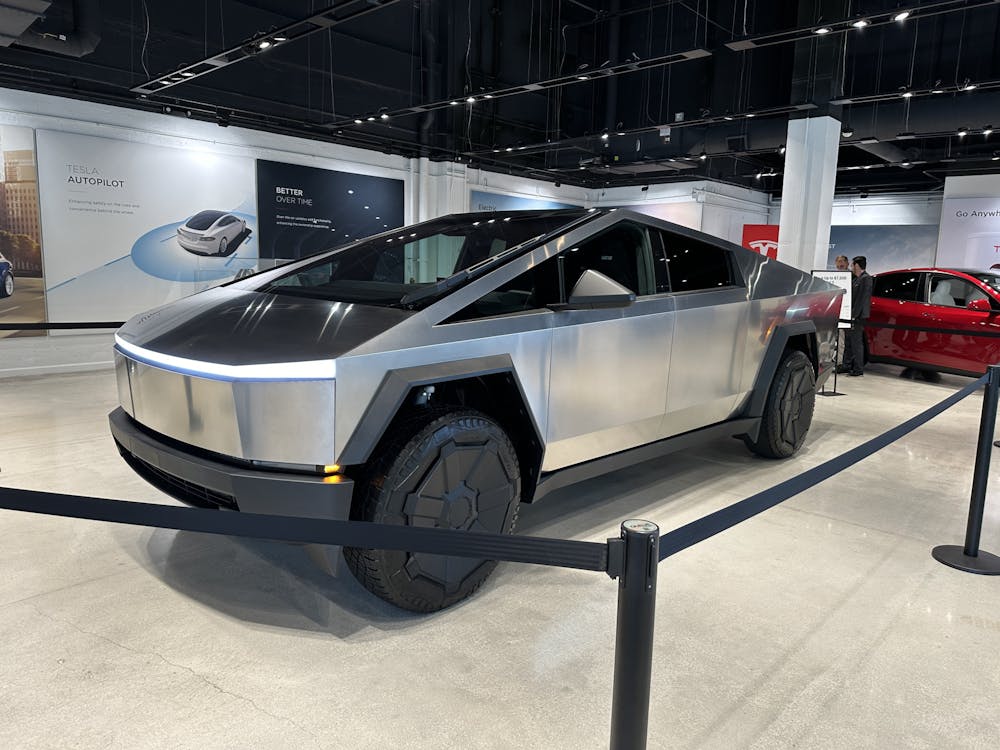Sharp angles. Bare sides. Flat features. Only lines.
Am I talking about Picasso’s 1907 Les Demoiselles d’Avignon or about Elon Musk’s relatively new Cybertruck? If you weren’t sure either, maybe you’ve already made the connection that the Cybertruck is our modern version of cubist artwork. We’ve moved away from the canvas and oil paints and ventured into the world of stainless steel and armor glass.
Analogous to the Metropolitan Museum’s description of Picasso’s painting as “stylization and distortion” of the traditional art concepts, we saw Musk looking for shock-factor and dramatic differentiation as he entered the truck manufacturing space. Both Picasso and Tesla’s chief designer, Franz von Holzhausen, embraced geometry and stark two-dimensionality — reducing the desire for volume, curvature and conventional aerodynamics. The result is a shared appreciation for rigidity and intensity that challenges established aesthetics.
These two groundbreaking designs are one of the first of their kind, making them not only easily recognizable, but the benchmark that future variations and developments will compare back to and past versions look towards. Much like Paul Cézanne’s landscapes are commonly known as precursors of Picasso’s figures, early electric pickups like the Rivian R1T (released a year before the Cybertruck) precede von Holzhausen's design.
The paragon piece of a new artistic movement is often more memorable to the layman’s eye than the progression towards it. To Cézanne and Rivian’s dismay, when I say “cubism” you’ll say Picasso, and I’ll say Franz von Holzhausen. The latter drew inspiration from pop-culture, think “Blade Runner 2049” and the submarine car from “The Spy Who Loved Me” (a classic James Bond film). This was the same trend we saw in the years leading up to 1907, though “pop-culture” looked different and so did cultural context. Picasso’s figures' faces are modeled after African masks and their nude bodies allude to expanding prostitution across Europe.
Naturally, the two creators, separated by approximately a century, did not entirely neglect their predecessors’ ways, continuing to incorporate best-practices in the fields of oil painting and automotive design. Just as you learned in your middle school years, triangles remain the standard of stability and the separation of complementary colors persists as a tool of contrast.
In the Cybertruck’s design process, we’ve seen a myriad of variants, ranging from a Tesla-ified Ford-F150, to a smoother curved contour design, and the path from curvature to angles and rigidity is wholly evident. It serves as a clear parallel to Picasso’s transformative piece, where figures of three-dimensions and realistic volume are taken from curvature to primarily straight lines.
Yet, a contradiction in this analogy ensues: Picasso takes the three-dimensional and transfers it to a two-dimensional surface, choosing to omit the illusion of depth, whereas von Holzhaussen takes the three-dimensional vehicle and, by means of flattening its features, renders it to appear two-dimensional from almost all angles. While Picasso’s method is comprehensible, the latter’s isn't — it looks surreal.
Many would argue that this surreal nature is merely a factor of automotive design, falling short to the greater concerns of horsepower, precision steering, and enhanced braking systems. Yet, we would be dishonest if we said we didn’t care about the aesthetics, myself included. At the end of the day, it’s the first aspect we truly grasp at first glance. When we’re driving, we clock the cars on either side of us, knowing exactly which is the new muscle car of the year and which is the fully electric vehicle simply based on its exterior design.
Considering the latter point, maybe the Cybertruck is not anything extraordinary, simply a dramatization of the evolving aesthetic design of electric vehicles. I would agree except for one factor: The public’s reaction was quick, emotional, and intense, matching that of twentieth century Parisians in regard to cubist artwork in a largely unprecedented way. We can see that Tesla’s twist just hit differently than the others. Having reached a plateau in what met our eyes on the road, we needed an artistic renaissance to spark intrigue and conversation. Cybertruck did exactly that.
As we move forward, we can question whether the Cybertruck’s style will catch on and influence other manufacturer’s designs of the future, maybe even creating “surrealist” models we can select on the drop down menus, just as Picasso’s paintings influenced artists like Salvador Dali (arguably the most well known European Surrealist). Electric vehicles of Audi, Lexus, Volkswagen and Lucid have caught on to the “cubist” wave, with thin full bumper head and tail lights, while other makes are shaping their cars’ contours with sharper angles, aiming for that “edgy futuristic” look. However, a move into true surrealist car design is going to take an engineer's mind and an artist's intuition. Let’s see if Tesla has what it takes to become the Picasso-turned-Dali of the American highway.
Lana Milman is a junior from Baltimore, Md. majoring in Neuroscience and French.





